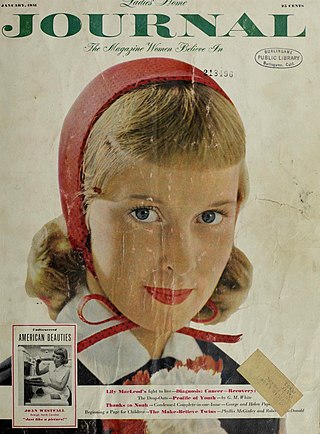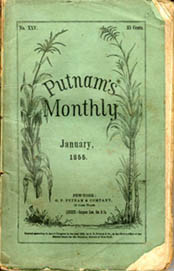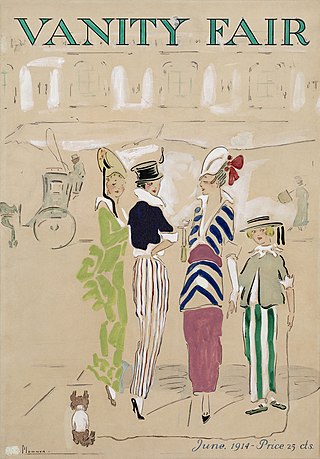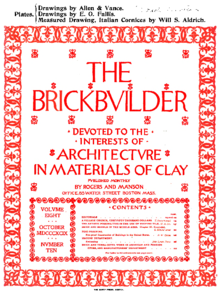
Ladies' Home Journal was an American magazine last published by the Meredith Corporation. It was first published on February 16, 1883, and eventually became one of the leading women's magazines of the 20th century in the United States. In 1891, it was published in Philadelphia by the Curtis Publishing Company. In 1903, it was the first American magazine to reach one million subscribers.

Harper's Weekly, A Journal of Civilization was an American political magazine based in New York City. Published by Harper & Brothers from 1857 until 1916, it featured foreign and domestic news, fiction, essays on many subjects, and humor, alongside illustrations. It carried extensive coverage of the American Civil War, including many illustrations of events from the war. During its most influential period, it was the forum of the political cartoonist Thomas Nast.
Physical Review is a peer-reviewed scientific journal established in 1893 by Edward Nichols. It publishes original research as well as scientific and literature reviews on all aspects of physics. It is published by the American Physical Society (APS). The journal is in its third series, and is split in several sub-journals each covering a particular field of physics. It has a sister journal, Physical Review Letters, which publishes shorter articles of broader interest.
High Fidelity — often abbreviated HiFi — was an American magazine that was published from April 1951 until July 1989 and was a source of information about high fidelity audio equipment, video equipment, audio recordings, and other aspects of the musical world, such as music history, biographies, and anecdotal stories by or about noted performers.

Wine Spectator is an American lifestyle magazine that focuses on wine, wine culture and wine ratings. It is the flagship publication of M. Shanken Communications, which also publishes Cigar Aficionado, Whisky Advocate, Market Watch, Shanken News Daily and Shanken’s Impact Newsletter.

George Franklin Barber was an American architect known for the house designs he marketed worldwide through mail-order catalogs. Barber was one of the most successful residential architects of the late Victorian period in the United States, and his plans were used for houses in all 50 U.S. states, and in nations as far away as Japan and the Philippines. Over four dozen Barber houses are individually listed on the National Register of Historic Places, and several dozen more are listed as part of historic districts.

Putnam's Monthly Magazine of American Literature, Science and Art was a monthly periodical published by G. P. Putnam's Sons featuring American literature and articles on science, art, and politics.

Archnet is a collaborative digital humanities project focused on Islamic architecture and the built environment of Muslim societies. Conceptualized in 1998 and originally developed at the MIT School of Architecture and Planning in co-operation with the Aga Khan Trust for Culture. It has been maintained by the Aga Khan Documentation Center at MIT and the Aga Khan Trust for Culture since 2011.

Architectural Record is a US-based monthly magazine dedicated to architecture and interior design. Its editor in chief is Josephine Minutillo. The Record, as it is sometimes colloquially referred to, is widely-recognized as an important historical record of the unfolding debates in architectural practice, history and criticism in the 20th-century United States. The magazine is currently published by BNP Media. Throughout its 133 years in print, Architectural Record has engaged readership among architecture, engineering, and design professionals through articles showcasing noteworthy architectural projects around the world. News, commentary, criticism, and continuing-education sections outline the scope of content. Of note are the glossy, high-quality photos of featured projects, which give the magazine wider readership outside of just those working in the design professions.

Scribner's Monthly: An Illustrated Magazine for the People was an illustrated American literary periodical published from 1870 until 1881. Following a change in ownership in 1881 of the company that had produced it, the magazine was relaunched as The Century Magazine.

Structuralism is a movement in architecture and urban planning that evolved around the middle of the 20th century. It was a reaction to Rationalism's (CIAM-Functionalism) perceived lifeless expression of urban planning that ignored the identity of the inhabitants and urban forms.
Objectivist periodicals are a variety of academic journals, magazines, and newsletters with an editorial perspective explicitly based on Ayn Rand's philosophy of Objectivism. Several early Objectivist periodicals were edited by Rand. She later endorsed two periodicals edited by associates, and a number of others have been founded since her death.

Vanity Fair was an American society magazine published from 1913 to 1936. It was highly successful until the Great Depression led to its becoming unprofitable, and it was merged into Vogue in 1936. In the 1980s, the title was revived.

Julius Adolphe Schweinfurth was an American architect, artist, and designer.

Architecture was a monthly magazine on architecture, established by A. Holland Forbes in 1900 with its first issue dated January 15. Each issue was lavishly illustrated with photographs and architectural drawings. The magazine was published by Forbes & Company, Ltd., initially located at 160 Fifth Avenue, New York, and beginning with the issue of May 15, 1907, at 225 Fifth Avenue. A. Holland Forbes was listed on the masthead as the editor until June 15, 1903, when these duties were taken over by a Board of Architects "in the interests of the profession."

Peter M. Wolf is an American author, land planning and urban policy authority, investment manager, and philanthropist. He lives in New York City.

Kultur im Heim was an East German women's magazine specializing on home decoration and home design. The magazine was published between 1956 and 1989.

Frederick S. Holmes was an American safe and vault engineer, and inventor who designed the largest vaults in the world. During his career, Holmes designed hundreds of vaults throughout the United States, Canada and Japan from 1895 to 1941. The majority of Holmes designed vaults are located in New York's Financial District; many are publicly accessible and in buildings on the National Register of Historic Places. His name is engraved on the builder's plaques, typically located on the encased jamb controls of these vaults.















